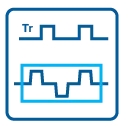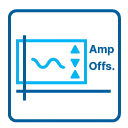Product:
M2p.6566-x4
16 bit Arbitrary Waveform Generator
Description:
The M2p.65xx series offers different versions of arbitrary waveform generators for PCI Express with a maximum output rate of 125 MS/s. These boards allow to generate freely definable waveforms on several channels synchronously. With one of the synchronization options the setup of synchronous multi channel systems is possible as well as the combination of arbitrary waveform generator with digitizers of the M2p product family. The 512 MSample on-board memory can be used as arbitrary waveform storage or as a FIFO buffer continuously stream data via the PCIe interface. Importantly, the high-resolution 16-bit DACs deliver four times the resolution than AWGs using older 14-bit technology.
Facts & Features:
- Up to 125 MS/s on 4 channels
- Output level ±6 V into High Impedance
- Output level ±3 V into 50 Ohm
- 16 bit arbitrary waveform generator
- Simultaneous signal generation on all channels
- Fixed trigger to output delay
- Single-Shot, Loop, Gated, Sequence Mode
- 4 digital outputs (Marker) standard, 16 more as option
- Synchronization of up to 16 cards
- Internal Synchronization with matching Digitizers
- PCIe x4 Gen1 Interface
- Works with x4/x8/x16* PCIe slots
- Software compatible to PCI
- Sustained streaming mode up to 700 MB/s
- Direct data transfer to / from CUDA GPU using SCAPP
Product-Video:
Application examples:
- Antenna Arrays
- Research and Development
- Stimulus-Response Tests
- Closed Loop Tests

FIFO mode
The FIFO mode is designed for continuous data transfer between measurement board and PC memory or hard disk. The read (acquisition) transfer rate reached depends on the motherboard and can be up to 700 MByte/s on a PCI Express x4 Gen1 slot. The control of the data stream is done automatically by the driver on interrupt request. The complete installed on-board memory is used for buffer data, making the continuous streaming extremely reliable.
Repeated Output
When repeated output is used the data of the on-board memory is replayed continuously until a stop command is executed or N times. As trigger source one can use the external TTL trigger or the software trigger.
Sequence Replay Mode
The sequence mode allows to split the card memory into several data segments of different length. These data segments are chained up in a user chosen order using an additional sequence step memory with the ability to program loops and triggers and to reload data while output is running.
Single Restart
When this mode is activated the data of the on-board memory will be replayed once after each trigger event. As Trigger source one can use the external TTL or software trigger.
Singleshot Output
When singleshot output is activated the data of the on-board memory is replayed exactly one time. As trigger source one can use the external TTL trigger or the software trigger.

Digital Pulse Generator Option
The digital pulse generator option adds 4 internal independent pulse generators with programmable duty cycle, output frequency, delay and number of loops. These pulse generators can be triggered by software, hardware trigger or can trigger each other allowing to form complex pulse schemes to drive external equipment or experiments. The pulse generators can be outputted on the existing multi-XIO lines or can be used to trigger the instrument internally. Time resolution of the pulse generator depends on the cards type and the selected sampling rate and can be found in the technical data section.

External Trigger
All boards can be triggered using a separate external trigger signal with a two level programmable window comparator and a second separate external trigger with a single programmable level comparator. It's possible to use positive or negative edge. An internally recognized trigger event can - when activated by software - be routed to a multi purpose i/o connector to start external instruments.

Gated Replay
The Gated Sampling option allows data replay controlled by an external gate signal. Data is only replayed if the gate signal has a programmed level.
Multi Purpose I/O
The card offers universal multi purpose I/O lines, which can be separately programmed as either input or output. These lines can be used as additional TTL trigger inputs for more complex trigger conditions.
Multiple Replay
The Multiple Replay option allows the fast repetition output on several trigger events without restarting the hardware. With this option very fast repetition rates can be achieved. The on-board memory is divided in several segments of same size. Each of them is generated if a trigger event occurs.
External Clock
Using a dedicated connector a sampling clock can be fed in from an external system. It's also possible to output the internally used sampling clock to synchronize external equipment to this clock.

High Precision PLL
The internal sampling clock of the card is generated using a high precision PLL. This powerful device allows to select the sampling rate with a fine step size making it possible to perfectly adopt to different measurement tasks. Most other cards on the market only allow the setup of fixed sampling rates like 100 MS/s, 50 MS/s, 25 MS/s, 10 MS/s, ... without any possibility to set the sampling rate to any value in between.
Reference Clock
The option to use a precise external reference clock (normally 10 MHz) is necessary to synchronize the board for high-quality measurements with external equipment (like a signal source). It's also possible to enhance the quality of the sampling clock in this way. The driver automatically generates the requested sampling clock from the fed in reference clock.Digital Outputs/Marker Outputs
Additional synchronous digital channels (markers) can be replayed phase-stable with the analog data. When this mode is active up to four additional digital marker outputs can be used by reducing the analog resolution of the D/A converter. As an option 16 more digital outputs are available.

Programmable Amplitude
The Spectrum Arbitrary Waveform Generators are equipped with a very wide programmable output amplitude. This allows to adapt the output signal level to the needs of the stimulated device while also having the maximum output resolution available for the signal.






This standard driver is included in the card delivery and it is possible to get the newest driver version free of charge from our homepage at any time. There are no additional SDK fees for the classical text-based programming. All boards are delivered with drivers for Windows 7, Windows 8, Windows 10 and Windows 11, all 32 bit and 64 bit.
| Product | Channels | Max. Samplerate | Max. Bandwidth |
|---|---|---|---|
| M2p.6530-x4 | 1 | 40 MS/s | 20 MHz |
| M2p.6531-x4 | 2 | 40 MS/s | 20 MHz |
| M2p.6533-x4 | 8 | 40 MS/s | 20 MHz |
| M2p.6536-x4 | 4 | 40 MS/s | 20 MHz |
| M2p.6540-x4 | 1 | 40 MS/s | 20 MHz |
| M2p.6541-x4 | 2 | 40 MS/s | 20 MHz |
| M2p.6546-x4 | 4 | 40 MS/s | 20 MHz |
| M2p.6560-x4 | 1 | 125 MS/s | 60 MHz |
| M2p.6561-x4 | 2 | 125 MS/s | 60 MHz |
| M2p.6568-x4 | 8 | 125 MS/s | 60 MHz |
| M2p.6570-x4 | 1 | 125 MS/s | 60 MHz |
| M2p.6571-x4 | 2 | 125 MS/s | 60 MHz |
| M2p.6576-x4 | 4 | 125 MS/s | 60 MHz |
| On different platforms | Bus | Max. Bus Transfer speed |
|---|---|---|
| DN2.656-04 | Ethernet | 70 MByte/s |

Streaming Systems (Optional)
Combining a number of Spectrum M2p/M2i/M3i/M4i/M5i PCIe digitizers with a Tera-Store Data Streaming solution allows the capture and storage of long complex signals for extended periods of time. With systems available offering from 1 to 32 TB of storage and streaming rates up to 3 GB/s signals can be digitized and stored seamlessly for hours on end.
Documents
Data sheet of the M2p.65xx series |
23.02.2024 | 1 M | ||
Manual of M2p.65xx family |
23.02.2024 | 15 M | ||
Short Manual for IVI Driver |
21.02.2022 | 532 K | ||
Manual for LabVIEW drivers for M2p |
08.12.2023 | 5 M | ||
Manual for MATLAB driver M2p/M4i/M4x/M5i/M2i/M3i/DN2/DN6 |
13.12.2023 | 1 M | ||
SCAPP Manual |
08.12.2023 | 618 K |
WINDOWS DRIVER + SOFTWARE
M2p/M4i/M4x/M5i/M2i/M3i/DN2/DN6 driver for Windows 7, 8, 10, 11 (32/64 bit) |
7.00 | 23.02.2024 | 5 M | |
C/C++ driver header and library files |
7.00 | 23.02.2024 | 43 K | |
IVI Driver for IVI FGen class (32 bit) |
23.02.2024 | 3 M | ||
Spectrum Control Center (32-bit) / Windows 7, 8, 10 |
2.35 | 23.02.2024 | 22 M | |
Spectrum Control Center (64-bit) / Windows 7, 8, 10, 11 |
2.35 | 23.02.2024 | 25 M | |
SBench 6 (32-bit) Installer / Windows 7, 8, 10 |
6.5.07 | 23.02.2024 | 36 M | |
SBench 6 (64-bit) Installer / Windows 7, 8, 10, 11 |
6.5.07 | 23.02.2024 | 39 M | |
Windows Installer for Remote Server Option |
23.02.2024 | 13 M | ||
M2i/M2p/M3i/M4i/M4x/M5i/DN2/DN6 LabView driver installer |
23.02.2024 | 19 M | ||
M2p/M4i/M4x/M5i/M2i/M3i/DN2/DN6 Matlab driver + examples installer |
23.02.2024 | 7 M | ||
Windows Examples (C/C++, .NET, Delphi, Java, Python, Julia ...) |
7.00 | 23.02.2024 | 2 M |
LINUX DRIVER + SOFTWARE
M2p/M4i/M4x/M5i/M2i/M3i drivers (Kernel + Library) for Linux 32 bit and 64 bit |
7.00 | 23.02.2024 | 12 M | |
Driver libraries (no Kernel) for Linux 32 bit and 64 bit |
7.00 | 23.02.2024 | 9 M | |
Spectrum Remote Server Linux Installer Package |
23.02.2024 | 12 K | ||
Spectrum Control Center |
2.35 | 07.03.2024 | 57 M | |
SBench 6 Linux 32 (.rpm) |
6.5.07 | 23.02.2024 | 26 M | |
SBench 6 Linux 64 (.rpm) |
6.5.07 | 23.02.2024 | 26 M | |
SBench 6 Linux 32 (.deb) |
6.5.07 | 23.02.2024 | 23 M | |
SBench 6 Linux 64 (.deb) |
6.5.07 | 23.02.2024 | 22 M | |
SBench6 Jetson (.deb) |
6.5.07 | 23.02.2024 | 8 M | |
Drivers + examples for MATLAB for Linux (DEB + RPM) |
23.02.2024 | 183 K | ||
Linux Examples (C/C++, Python, Julia ...) |
7.00 | 23.02.2024 | 556 K |
Firmware
M2i/M2p/M3i/M4i/M4x/M5i firmware update (Windows) |
23.02.2024 | 22 M | ||
M2i/M2p/M3i/M4i/M4x/M5i firmware update (Linux) |
23.02.2024 | 30 M |
Case Studies
| MRI Scanner for Babies | Shrunken MRI scanner helps in saving lives of sick babies |
21.02.2022 | 195 K | |
| CS BYU Underwater Acoustics Lab | Case Study Sound waves studied in a simulated ocean with high-precision PCIe measurement cards |
18.11.2022 | 469 K |
Product Notes
| Trigger and Sync | Trigger, Clock and Synchronization Details at high-speed Digitizers |
21.02.2022 | 1 M | |
| Digitizer Software Integration | Software Support for Modular Digitizers |
21.02.2022 | 724 K | |
| SBench 6 Introduction | SBench 6 - Data Acquisition and Analysis of Digitizer Data |
21.02.2022 | 1 M | |
| AWG Waveforms | Creating AWG Waveforms in SBench 6 using Equations |
21.02.2022 | 479 K | |
| Create & Capture AWG Waveforms | Creating , Capturing and Transferring Waveforms for AWG's using SBench 6 |
21.02.2022 | 2 M |
Application Notes
| RF Measurements | RF Measurements using a modular Digitizer |
21.02.2022 | 838 K | |
| Teaming AWG with Digitizer | Teaming an Arbitrary Waveform Generator with a Modular Digitizer |
21.02.2022 | 919 K | |
| Introduction to Modular Arbitrary Function Generators | An Introduction to Modular Arbitrary Function Generators |
21.02.2022 | 701 K | |
| Arbitrary Waveform Generator Operating Modes | Using Arbitrary Waveform Generator Operating Modes Effectively |
21.02.2022 | 481 K | |
| AN Closed Loop Digitizer+AWG | Application Note: Closed Loop Tests with Digitizer and AWG and CUDA-GPU |
21.02.2022 | 2 M | |
| AN Multi-Channel T&M Systems | Easy creation of customized multi-channel, multi-functional T&M systems |
21.02.2022 | 2 M |

